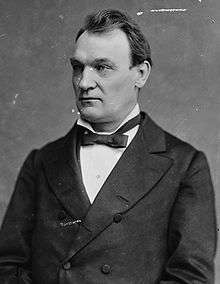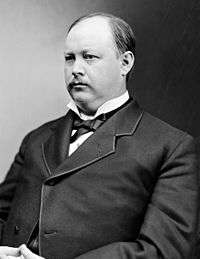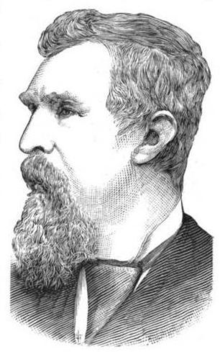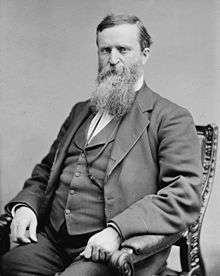United States House of Representatives elections, 1886
| | |||||||||||||||||||||||||||||||||||||||||||||||||||||||||||||||
| |||||||||||||||||||||||||||||||||||||||||||||||||||||||||||||||
| |||||||||||||||||||||||||||||||||||||||||||||||||||||||||||||||
|
| |||||||||||||||||||||||||||||||||||||||||||||||||||||||||||||||
| Map of U.S. House elections results from 1886 elections for 50th Congress | |||||||||||||||||||||||||||||||||||||||||||||||||||||||||||||||
| |||||||||||||||||||||||||||||||||||||||||||||||||||||||||||||||
Elections to the United States House of Representatives were held in 1886 for Representatives to the 50th Congress, taking place in the middle of President Grover Cleveland's first term.
As in many midterm elections, Cleveland's Democratic Party lost seats to the opposition Republican Party, although a narrow majority was retained. Many of these Republican pickups were in the industrializing Midwest states, where the debate over tariffs, which were advocated by Republicans to protect domestic industry but opposed by Democrats to allow for free agricultural trade, led to political change. The small Labor Party, supported by industrial workers, gained one seat each in Virginia (VA-06) and Wisconsin (WI-04), while the Greenback Party maintained its one seat in Iowa (James B. Weaver of IA-06). John Nichols was also elected as an Independent to NC-04.
Election summaries
| State | Type | Total seats |
Democratic | Republican | Others | |||
|---|---|---|---|---|---|---|---|---|
| Seats | Change | Seats | Change | Seats | Change | |||
| Alabama | District | 8 | 8 | |
0 | |
0 | |
| Arkansas | District | 5 | 5 | |
0 | |
0 | |
| California | District | 6 | 2 | |
4 | |
0 | |
| Colorado | At-large | 1 | 0 | |
1 | |
0 | |
| Connecticut | District | 4 | 2 | |
2 | |
0 | |
| Delaware | At-large | 1 | 1 | |
0 | |
0 | |
| Florida | District | 2 | 2 | |
0 | |
0 | |
| Georgia | District | 10 | 10 | |
0 | |
0 | |
| Illinois | District | 20 | 6 | |
14 | |
0 | |
| Indiana | District | 13 | 6 | |
7 | |
0 | |
| Iowa | District | 11 | 1 | |
9[Note 4] | |
1[Note 5] | |
| Kansas | District | 7 | 0 | |
7[Note 4] | |
0 | |
| Kentucky | District | 11 | 8 | |
3 | |
0 | |
| Louisiana | District | 6 | 6 | |
0 | |
0 | |
| Maine[Note 6] | District | 4 | 0 | |
4 | |
0 | |
| Maryland | District | 6 | 5 | |
1 | |
0 | |
| Massachusetts | District | 12 | 4 | |
8 | |
0 | |
| Michigan | District | 11 | 5 | |
6 | |
0 | |
| Minnesota | District | 5 | 3 | |
2 | |
0 | |
| Mississippi | District | 7 | 7 | |
0 | |
0 | |
| Missouri | District | 14 | 12 | |
2 | |
0 | |
| Nebraska | District | 3 | 1 | |
2 | |
0 | |
| Nevada | At-large | 1 | 0 | |
1 | |
0 | |
| New Hampshire | District | 2 | 1 | |
1 | |
0 | |
| New Jersey | District | 7 | 2 | |
5 | |
0 | |
| New York | District | 34 | 16 | |
18 | |
0 | |
| North Carolina | District | 9 | 7 | |
1 | |
1[Note 7] | |
| Ohio | District | 21 | 6 | |
15 | |
0 | |
| Oregon[Note 6] | At-large | 1 | 0 | |
1 | |
0 | |
| Pennsylvania | District + at-large |
28 | 8 | |
20 | |
0 | |
| Rhode Island | District | 2 | 0 | |
2 | |
0 | |
| South Carolina | District | 7 | 7 | |
0 | |
0 | |
| Tennessee | District | 10 | 8 | |
2 | |
0 | |
| Texas | District | 11 | 11 | |
0 | |
0 | |
| Vermont[Note 6] | District | 2 | 0 | |
2 | |
0 | |
| Virginia | District | 10 | 3 | |
6 | |
1[Note 8] | |
| West Virginia | District | 4 | 3 | |
1 | |
0 | |
| Wisconsin | District | 9 | 1 | |
7 | |
1[Note 8] | |
| Total | 325 | 167[1] 51.4% |
|
154[1][Note 3] 47.4% |
|
4[1] 1.2% |
| |
There were 2 Labor Party and 1 Independent members elected, and 1 Greenback Party member re-elected in Iowa. The previous election saw just the Greenback elected.
| 167 | 2 | 1 | 1 | 2 | 152 |
| Democratic | La | I | Gb | IR | Republican |
[[File:50 us house membership.png|thumb|left|450px|
]] |
[[File:50 us house changes.png|thumb|left|450px|
]] | |||||||||||||||||||||||||||
Early election dates
In 1886, three states, with 7 seats among them, held elections early:
Complete list of races
- D: Democratic
- I: Independent
- Pr: Prohibition
- R: Republican
California
| District | Incumbent | Party | First elected |
Result | Candidates |
|---|---|---|---|---|---|
| California 1 | Barclay Henley | Democratic | 1882 | Incumbent retired. Democratic hold |
√ Thomas Larkin Thompson (D) 50.2% Charles A. Garter (R) 47.2% L. W. Simmons (Pr) 2.6% |
| California 2 | James A. Louttit | Republican | 1884 | Incumbent retired. Democratic gain. |
√ Marion Biggs (D) 50% J. C. Campbell (R) 47% W. O. Clark (Pr) 3% |
| California 3 | Joseph McKenna | Republican | 1884 | Incumbent re-elected. | √ Joseph McKenna (R) 53.1% Henry C. McPike (D) 44.6% W. W. Smith (Pr) 2.4% |
| California 4 | William W. Morrow | Republican | 1884 | Incumbent re-elected. | √ William W. Morrow (R) 48.7% Frank McCoppin (D) 42% Charles A. Sumner (I) 9% Robert Thompson (Pr) 0.4% |
| California 5 | Charles N. Felton | Republican | 1884 | Incumbent re-elected. | √ Charles N. Felton (R) 48.8% Frank J. Sullivan (D) 48.4% C. Henderson (Pr) 1.4% A. E. Redstone (I) 1.4% |
| California 6 | Henry Markham | Republican | 1884 | Incumbent retired. Republican hold |
√ William Vandever (R) 47.3% Joseph D. Lynch (D) 47.1% W. A. Harris (Pr) 5.6% |
Florida
| District | Incumbent | Party | First elected |
Result | Candidates |
|---|---|---|---|---|---|
| Florida 1 | Robert H. M. Davidson | Democratic | 1876 | Incumbent re-elected. | √ Robert H. M. Davidson (D) 66.2% C. B. Pendleton (R) 33.8% |
| Florida 2 | Charles Dougherty | Democratic | 1884 | Incumbent re-elected. | √ Charles Dougherty (D) 53.9% J. C. Greeley (R) 44.9% R. B. Norment (Pr) 1.2% |
South Carolina
| District | Incumbent | Party | First elected |
Result | Candidates |
|---|---|---|---|---|---|
| South Carolina 1 | Samuel Dibble | Democratic | 1882 | Incumbent re-elected. | √ Samuel Dibble (D) 99.9% Others 0.1% |
| South Carolina 2 | George D. Tillman | Democratic | 1878 | Incumbent re-elected. | √ George D. Tillman (D) 99.6% Others 0.4% |
| South Carolina 3 | D. Wyatt Aiken | Democratic | 1876 | Incumbent retired. Democratic hold. |
√ James S. Cothran (D) 99.8% Others 0.2% |
| South Carolina 4 | William H. Perry | Democratic | 1884 | Incumbent re-elected. | √ William H. Perry (D) 100% |
| South Carolina 5 | John J. Hemphill | Democratic | 1882 | Incumbent re-elected. | √ John J. Hemphill (D) 99.9% Others 0.1% |
| South Carolina 6 | George W. Dargan | Democratic | 1882 | Incumbent re-elected. | √ George W. Dargan (D) 98.7% Others 1.3% |
| South Carolina 7 | Robert Smalls | Republican | 1884 (special) | Incumbent lost re-election. Democratic gain. |
√ William Elliott (D) 52.0% Robert Smalls (R) 47.8% Others 0.2% |
See also
Notes
- ↑ Three states held early elections between June 7 and September 10.
- ↑ Included 1 Independent Democrat.
- 1 2 Includes 2 Independent Republicans, John Alexander Anderson elected to KS-05, and Albert R. Anderson to IA-08.
- 1 2 Includes 1 Independent Republican.
- ↑ Greenback Party
- 1 2 3 Elections held early.
- ↑ John Nichols was elected as an Independent to NC-04.
- 1 2 Labor Party
References
Bibliography
- Dubin, Michael J. (March 1, 1998). United States Congressional Elections, 1788-1997: The Official Results of the Elections of the 1st Through 105th Congresses. McFarland and Company. ISBN 978-0786402830.
- Martis, Kenneth C. (January 1, 1989). The Historical Atlas of Political Parties in the United States Congress, 1789-1989. Macmillan Publishing Company. ISBN 978-0029201701.
- Moore, John L., ed. (1994). Congressional Quarterly's Guide to U.S. Elections (Third ed.). Congressional Quarterly Inc. ISBN 978-0871879967.
- "Party Divisions of the House of Representatives* 1789–Present". Office of the Historian, House of United States House of Representatives. Retrieved January 21, 2015.
External links
- Office of the Historian (Office of Art & Archives, Office of the Clerk, U.S. House of Representatives)




